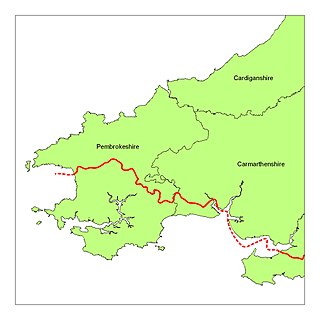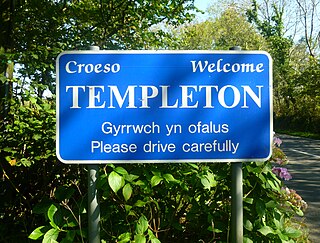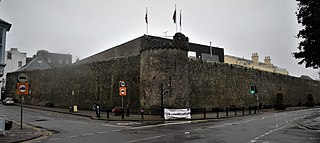Related Research Articles

Pembrokeshire is a county in the south-west of Wales. It is bordered by Carmarthenshire to the east, Ceredigion to the northeast, and the rest by sea. The county is home to Pembrokeshire Coast National Park. The Park occupies more than a third of the area of the county and includes the Preseli Hills in the north as well as the 190-mile (310 km) Pembrokeshire Coast Path.

Little England beyond Wales is a name that has been applied to an area of southern Pembrokeshire and southwestern Carmarthenshire in Wales, which has been English in language and culture for many centuries despite its remoteness from England. Its origins may lie in the Irish, Norse, Norman, Flemish and Saxon settlement that took place in this area more than in other areas of South West Wales. Its northern boundary is known as the Landsker Line.

Tenby is both a walled seaside town in Pembrokeshire, Wales, on the western side of Carmarthen Bay, and a local government community.

Pembroke Dock is a town and a community in Pembrokeshire, South West Wales, 3 miles (4.8 km) northwest of Pembroke on the banks of the River Cleddau. Originally Paterchurch, a small fishing village, Pembroke Dock town expanded rapidly following the construction of the Royal Navy Dockyard in 1814. The Cleddau Bridge links Pembroke Dock with Neyland.

The West Wales lines are a group of railway lines from Swansea through Carmarthenshire to Pembrokeshire, West Wales. The main part runs from Swansea to Carmarthen and Whitland, where it becomes three branches to Fishguard, Milford Haven and Pembroke Dock.

Narberth is both a town and a community in Pembrokeshire, Wales. It was founded around a Welsh court and later became a Norman stronghold on the Landsker Line. It became the headquarters of the hundred of Narberth. It was once a marcher borough. George Owen described it in 1603 as one of nine Pembrokeshire "boroughs in decay".

Saundersfoot is a large village and community in Pembrokeshire, Wales. It is near Tenby, both being holiday destinations. Saundersfoot lies in the Pembrokeshire Coast National Park and on the Pembrokeshire Coast Path. The village population was 3,361 in 2011. while the community had a population of 2,628.

Tenby railway station in Tenby is on the Pembroke Dock branch of the West Wales Line operated by Transport for Wales Rail, who also manage the station. Trains call here every two hours in each direction, westwards towards Pembroke and eastwards to Whitland, Carmarthen and Swansea.

Lamphey is both a village, a parish and a community near the south coast of Pembrokeshire, Wales, approximately 2 miles (3.2 km) east of the historic town of Pembroke, and 2 miles (3.2 km) north of the seaside village of Freshwater East. The 2011 census reported a population of 843.

The Landsker Line is a term used for the language border in Wales between the largely Welsh-speaking and largely English-speaking areas in Pembrokeshire and Carmarthenshire. The English-speaking areas, south of the Landsker line and known as Little England beyond Wales, are notable for having been English linguistically and culturally for many centuries despite being far from the England–Wales border.
Pembroke was a parliamentary constituency centred on the town of Pembroke in West Wales. It returned one Member of Parliament (MP) to the House of Commons of the Parliament of the United Kingdom, elected by the first past the post system.

Templeton is a village and community in Pembrokeshire, Wales. The population of the community was 943 in 2011. The built-up area had a population of 627.

St Florence is both a village, a parish and a community in Pembrokeshire, Wales. St Florence sits on the River Ritec that flows 4 miles (6 km) eastwards to its estuary in Tenby. The Church of St Florence is a grade II* listed building.

Richard Vaughan, 2nd Earl of Carbery KB, PC, styled The Honourable from 1621 until 1628 and then Lord Vaughan until 1634, was a Welsh soldier, peer and politician.
Haverfordwest Bank is a defunct Welsh bank which was located in Haverfordwest, Pembrokeshire. It was established in the 18th century by a Jewish entrepreneur who settled in Wales.
Union Bank was a bank operated by the firm of Bateman & Co. and it is listed in the London Directory for 1807. However, the date of establishment of the bank is unknown.
This Bank was probably founded in 1802. It was established in Pembrokeshire, with a branch at Milford and was one of the banks founded as a result of the Bank of England stopping cash payments in 1797.
This bank was operating in Pembrokeshire, in Wales during the early 19th century. It became bankrupt in 1826.
Lock, Hulme & Co. was a bank in Pembrokeshire, Wales.

The Tenby town walls are Grade I-listed medieval defensive structures around the town of Tenby in Pembrokeshire. They are assessed as one of the most important surviving medieval city walls in Britain. The walls were built in the 13th century by the Earls of Pembroke and improved in the 1450s. They were last known to have been repaired in 1588 and have declined thereafter. Most of the town's gates were demolished beginning in the 18th century and only one survives.
References
- 1 2 3 Green, Francis, ed. (1916). "Early Banks in West Wales". West Wales historical records : the annual magazine of the Historical Society of West Wales. Vol. 6. Printed by W. Spurrell and Son. p. 154. OCLC 568027779 . Retrieved 11 October 2019.
- ↑ Crosby's Complete Pocket Gazetteer of England and Wales. London: Baldwin, Cradock & Joy. 1815. p. 466.